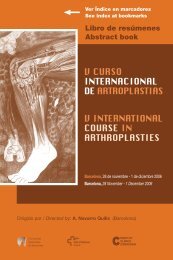Notas / Notes - Active Congress.......
Notas / Notes - Active Congress.......
Notas / Notes - Active Congress.......
You also want an ePaper? Increase the reach of your titles
YUMPU automatically turns print PDFs into web optimized ePapers that Google loves.
MARTES / TUESDAY<br />
26<br />
interlock between implant and bone. The European designs<br />
had instead a roughened surface produced on a titanium<br />
alloy stem by “corundum blasting” the surface to a specific<br />
roughness but with out a specific porous coating. This<br />
treatment was expected to provide a surface onto which<br />
bone could grow to provide for long-term, secondary stability.<br />
There have been reports in the literature of successes with<br />
the Zweymüller and Spotorno (CLS) prostheses. With now<br />
more than 1,000,000 of these types of stems in place world<br />
wide, the clinical success of these tapered, wedge shaped<br />
prostheses suggests that this European philosophy is one<br />
that will continue into the decades to come. Survivorships in<br />
excess of 95% at as long as 20 years have been reported with<br />
no indication on radiograph of impending failure on the horizon.<br />
The results of these prostheses, coupled with the good results<br />
obtained with the AML type prostheses, suggest that<br />
we look at the similarities of the implants to discern the requirements<br />
for obtaining fixation of a femoral stem. The stages<br />
of fixation can be summarized as primary fixation, intermediate<br />
fixation and secondary fixation.<br />
- Primary fixation is that obtained in the operating room<br />
by driving a slightly oversized or wedge shaped implant<br />
into the bone. The interference of the stem in the bone<br />
leads to high pressure at the implant-bone interface and<br />
a “press-fit”.<br />
- Intermediate fixation is the means by which the implant<br />
remains stable while bone attaches itself to the implant<br />
for long-term stability.<br />
- Secondary fixation is that obtained by apposition of bone<br />
to a rough surface or apposition of bone to the surface<br />
and ingrowth into the depth of a porous coating. Interference<br />
probably disappears with bone remodeling and<br />
all long-term stability is from bone apposition to the surface<br />
of the implant.<br />
After secondary fixation is obtained the effects of bone loss<br />
through osteoporosis, fracture of the interface or debris or<br />
infection induced dissolution of the interface may cause an<br />
implant to become unstable in the bone. Continued postimplantation<br />
surveillance of implanted prostheses is imperative<br />
to determine the rate and potential solutions to late problems.<br />
Since different femoral components have similar results with<br />
respect to fixation, it is of more importance today to consider<br />
the functional restoration of a hip rather than the specifics of<br />
the stem. The surgeon should choose a stem with which he<br />
or she is comfortable and can reliably attain good primary<br />
fixation. Post operative care should take into account the<br />
shape and history of the stem so that the intermediate period<br />
can lead to osseointegration.<br />
In my practice, both porous coated and surface roughened<br />
implants have been successful in the long term. Having had<br />
to revise porous coated implants, particularly those that have<br />
achieved extensive ingrowth into porous coating in the diaphysis<br />
(such as the AML), I prefer the surface roughened alternative.<br />
REFERENCES<br />
Blaha JD: Pressfit Femoral Components in The Adult Hip Callahan<br />
JJ, Rosenberg AG and Rubash HE eds. 2nd ed. in press.<br />
BASIC SCIENCE OF HA-COATINGS<br />
Rudolph Geesink, MD PhD<br />
Professor of Orthopaedic Surgery, Maastricht University,<br />
Netherlands<br />
Cementless fixation of hip implants has evolved through<br />
several stages of evolution since the last decades. Results<br />
of mechanical presfit implantation resulted in lack of adequate<br />
long term fixation. Unavoidable increase in micro-motion between<br />
the stiff implant and the more flexible bone during<br />
loading through difference in elastic modulus of both components<br />
resulted in unacceptably high loosening rates. More<br />
rigid fixation would be required between implant and bone<br />
to withstand all forces during daily activities. Second generation<br />
fixation using porous-coatings using beads or meshes<br />
represented a significant step forward although the interface<br />
biology was far from ideal. Both experimental and autopsy<br />
retrieval studies confirmed that average ingrowth surface of<br />
porous-coated implants rarely exceeded 10 - 15 % of available<br />
ingrowth surface. In clinical practice this may be adequate<br />
to provide long term stability, however the reliability of the<br />
system to provide durable fixation can easily be impaired by<br />
adverse actions of the surgeon such as accidental undersizing,<br />
varus positioning or adverse patient parameters such as<br />
impaired bone quality as in osteoporosis, rheumatoid arthritis<br />
or otherwise. Substantial increase in ingrowth fixation potential<br />
of implants can be achieved by providing HA-coatings in<br />
implant surfaces. HA-coatings of good quality should have<br />
both adequate mechanical and biological properties.<br />
Main advantages of HA-coatings in clinical practice:<br />
- reduce the time for implant fixation & rehabilitation<br />
- minimize relative motion between bone and implant<br />
- allow more normal physiological stress transfer<br />
- encourage gap filling between implant and bone<br />
- seal periprosthetic access channels for fluid & particles<br />
Results of experimental studies by many authors confirm the<br />
superior behavior of HA-coatings to achieve these goals<br />
while autopsy retrieval studies confirm improved results in<br />
clinical practice for a great variety of patient populations, including<br />
rheumatoid arthritis patients, patients suffering from<br />
osteoporotic bone or other adverse phenomena.





